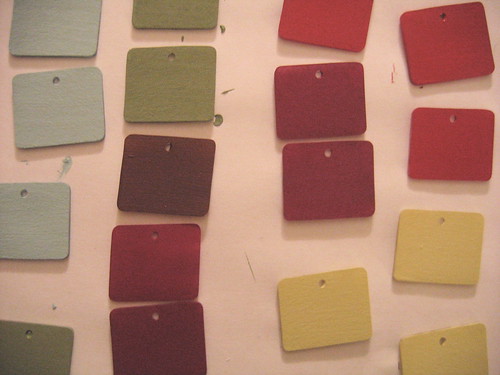
* The title of the Joseph Cornell exhibit at SF MOMA which was the impetus for my trip was “Navigating the Imagination.” So, yes, this blog post title is almost 100% stolen.
It’s been over a month since my
fairytale trip to San Francisco (getting to see the major Cornell exhibit, traveling with someone who actually wanted to go to thrift stores, seeing an art show about book covers, etc. etc. etc.) and I have yet to go back and find the books, websites and artists I made notes about. Here - do it with me (and enjoy some stories on the way):
• Reading the New York Times (Friday, 10/26) all the way through while waiting for my flight out of PDX. Things from various articles I wrote down:
-
www.carstennicolai.de- L.A. artists Amir Zaki, James Welling, Catherine Opie, Matt Mullican
-
David Lynch to his actors: “You are solid.”
- Sleepwalkers video by Doug Aiken projected on the side of NYC MOMA
- Ghiberti’s “Gates of Paradise” will be at the Seattle Art Museum in the next year- and won’t leave Italy again after
- Mary Cassatt drypoint/aquatint print “Gathering Fruit”
- “Staring Back” photos at Peter Blum Chelsea gallery by Chris Marker. Films of his?
• From AIGA 50 Books/50 Covers exhibit at Chronicle Books HQ:
- Robert Polidori: After the Flood
• At the AIGA event, running into a woman in a red hat and cape we had chatted with earlier that day during an incredibly crowded, rowdy bus ride. Turns out she’s the co-founder of the San Francisco Center for the Book.
• The Ferry Building in general as a wonderful wonderland of incredible food. Especially Brianna’s Corner’s Custard Bomboloni and just about anything from Boulette’s Larder.
• Seeing a guy at the crowded farmer’s market and thinking - I think that’s
Rena’s husband. But no, I’m sure it’s not - I’ve only seen, like, two pictures of him on flickr. Then asking Rena later in the day if Derek had been in the market that morning, to which she replied, “Yeah, did you see him?” to which I replied, “Yeah, I totally did.”
• Also at
Rare Device, running into
Susan Stars, a fellow Portlander and national craft celebrity. I’d brought a few of my necklaces along on the trip with the thought of giving one or more away to people if the occasion presented itself. There it was. That was neat.
• The engulfing, spectacular, and magical rooms at SF MOMA where I saw more things by Joseph Cornell all in one place than I’ll probably ever see again in my life. And the
accompanying ginormous book has the most beautiful reproductions of his work I’ve ever seen. Yes, I bought it.
• From one of the curator’s placards in the Joseph Cornell exhibit:
“European royalty and affluent professionals from the 1500s to the 1700s gathered works of art, illustrated texts and maps, coins, scientific devices, seashells, and other natural specimens from around the world to create "cabinets of curiosities." Dense arrangements in drawers, chests, and glass-fronted cases in private chambers suggested a collector's highly personal view of the cosmos in miniature. Like his European counterparts, Cornell assembled elements in a matrix of metaphors designed to incite wonder, curiosity, and contemplation about the physical and spiritual interrelationship of man and nature.
Cornell also absorbed his family's Victorian sensibility of gathering and recycling things as talismans of ‘what else were scattered and lost.’ Well-furnished Victorian homes featured ‘art corners’ with assorted natural and cultural souvenirs displayed on shelves or in curio cabinets. For the first time in Western culture, children were encouraged to collect as an educational activity, and their containers of personal treasures were dubbed ‘schoolboys’ museums.” In combining the traditions of two eras, Cornell expressed his appreciation of curiosity as an ongoing and intimate pursuit of knowledge and experience.”
Read more text from the exhibit
here.
• Books mentioned in the exhibit as being influential for Cornell at some time in his life that seem worth finding out more about:
- The Riddle of Emily Dickinson
- Ann of Oxford Street
• My own note: “Love of birds: willingness to accept on a deep level the otherness of animals.”
• On a crowded elevator, listening to an SF MOMA tour guide recount a story about the first group she ever led, which was comprised of senior citizens: “'I think we can fit everyone on the elevator - I don’t want to lose anyone.' To which a voice in the back corner of the elevator replied, ‘There are a few people I wouldn’t mind losing.’”
• Books at the SF MOMA store:
- Tico and the Golden Wings
- Stones, Bones & Stitches
- The Art Book for Children
- Pre-Zolo
- Reading Women
- The New Earth From Above
- Living Artfully
- Punk House
- The Plentitude, Rich Gold
- Wabi Sabi
- Foolsgold
- Atlas Schmatles
- Picturing & Poeting
- The Age of Feminine Drawing
• Notes from the SF Museum of Art & Craft
- Book: Celebrating Modern Art: The Anderson Collection
- Book: The Arts & Crafts Movement in California
- Artist: Squeak Carnwath
- Web: hirokokurihana.com
- Artist: Marcie McGoldrick - ceramics
• Made note of the name “Marie Watts” ?
• A Coloring Book For the Lazy by Harriet Russell - seen at Rare Device in
“Play Pen” a book featuring children’s illustrators.
• In the Castro District, trying to get to Tartine Bakery and having major navigational challenges. Forced to get breakfast at the nearest location or face fainting/escalation of crankiness. Ending up at Little Orphan Andy’s, the hangout of pretty much exclusively gay men. One of the waiters was wearing a utilikilt, S&M suspenders, and a black leather belt with the word NUDIST spelled out in silver studs. Despite being outsiders, we were treated with extreme kindness by our waiter, who referred to his customers as “my darlings,” “my pumpkins,” etc. We were referred to as “gentlewomen.” I’ll take it. Laurie took a
picture of the menu.
• Seeing the Darjeeling Limited at the Sundance Kabuki Theater in Japantown.
• Looking hard for a particular store that held the promise of being like walking though a Jospeh Cornell box , being disappointed with the reality of it then stumbling on Yone Beads (thanks to Laurie's keen eye), without a doubt the
most magical and amazing bead store I've even been in. Yone Beads was like being in Joseph Cornell's basement workshop - special trinkets and colors and history everywhere.
Truly amazing trip. Good thing I scheduled in all that serendipity.













